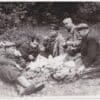Every time I present a talk, there’s a recurring inquiry. As a curator of political history at the Smithsonian Institution, when I delve into the extensive history of political divisions in our country, a member of the audience invariably claims that we cannot equate past divisions with those today, asserting that our media environment is inflicting unparalleled damage not witnessed in earlier times.
I’m consistently struck by the public’s perception of a tranquil media landscape in the past, envisioning it as a serene era before the internet disrupted everything.
In reality, the most polarized period in U.S. democracy—the mid-1800s—overlapped with a rapid expansion of new communication technologies, adversarial political figures, rampant misinformation, and fierce debates over free speech. This media environment contributed to the onset of the Civil War.
It’s essential to recognize that while 21st-century media may not mirror that of the 19th century, the belief that the past was filled with noble, unbiased journalists is misplaced.
Central to this tumultuous era was a peculiar yet significant movement—the Wide Awakes—which emerged from this very media landscape and engaged in fierce battles through newspapers, polling sites, and, ultimately, on battlefields across the nation.
From Snark to High-Minded Abolitionism
Newspapers have existed for centuries, yet as literacy rates surged in America, millions of ordinary citizens turned into avid readers of daily news.
The quantity of newspapers exploded from a mere handful in 1800 to approximately 4,000 contentious publications by 1860, collectively printing billions of pages every year. These ranged from the sarcastic and widely popular New York Herald and sensational crime stories from the National Police Gazette to the principled abolitionist stance of The Liberator.
This influx of readers included a diverse audience—from wealthy elites to school-aged girls and enslaved individuals legally barred from reading. Newspapers often published scandals and gossip, inciting crowds and resulting in frequent assaults on editors—often carried out by rival editors.
As late as the 20th century, communities were still removing newspaper presses from local rivers, having been tossed there by enraged mobs.
The vast majority of newspapers were overtly political, with about 95% showing explicit partisan affiliations. Many were directly financed by political parties. There was no notion of journalistic independence and impartiality until the early 20th century.
These partisan publications, rather than the government, were responsible for printing ballots. Voters would cut election ballots from the pages and deliver them to the voting stations. Imagine if today’s influencers were tasked with overseeing elections.
The advent of the telegraph, while it may seem antiquated now, revolutionized the spread of news from the 1840s onward, allowing Americans to share breaking news across vast distances via electrical wires. It enabled nationwide debates on various issues long before the age of the internet, television, or radio.
Digesting Slavery’s Evils Daily
Political discussions in the press became a rallying point for the people.
In an era when political discourse was largely local, major parties avoided the contentious topic of slavery, adopting what Abraham Lincoln derided as a “don’t care” attitude. However, as Maine began to engage with Texas on issues, slavery swiftly became a central focus. By the 1850s, the North confronted the realities of slavery on a daily basis.
The National Era, an abolitionist newspaper based in Washington, was the first to publish Harriet Beecher Stowe’s gripping novel, Uncle Tom’s Cabin, which stands as the most significant antislavery work in history.
Conversely, the pro-slavery publication, De Bow’s Review, propagated an ambitious agenda to extend slavery across the nation. Individuals separated by vast distances engaged in debate on the issue, with editors often playing the role of facilitators, reaping profits from the outrage they stirred.
It was quite fitting that the Northern resistance to slavery’s expansion was spearheaded by the 19th-century equivalent of socially engaged youth avidly consuming newspapers. In the early months of the 1860 election, a group of young clerks in Connecticut formed a club to support the antislavery Republican Party. Residing in a state known for its high literacy rates and large newspaper readership, they took inspiration from a local editor’s observation that the Republicans seemed “Wide Awake” in the election, thus naming their organization the Wide Awakes.
Sporting military-like uniforms and conducting torch-lit rallies at night, they adopted an open eye as their emblem, giving rise to a movement that I explore in my recent book, “Wide Awake: The Forgotten Force that Elected Lincoln and Spurred the Civil War.” Their principal concern often transcended the complexities of slavery itself, focusing instead on the defense of a “Free Press” that would not be stifled by supporters of slavery, whether from the North or the South.
The enthusiasm of the Wide Awakes quickly surged through the national newspaper landscape. In just months following their inception, young Republicans were forming similar clubs from Connecticut to California.
These young activists learned to organize their groups through local newspapers. They cultivated a symbiotic relationship with America’s press: supporting sympathetic newspaper offices and confronting pro-slavery Democratic outlets. Editors who shared their anti-slavery views reciprocated by marching alongside the Wide Awakes and encouraging their readers to initiate further clubs, as exemplified by an Indiana newspaperman who suggested, “Cannot such an organization be gotten up in this town?”
While this movement cannot be regarded as independent journalism, it certainly propelled a significant political initiative. Within mere months, the Wide Awakes evolved into one of the largest partisan movements in American history, boasting an estimated membership of around 500,000—equivalent to roughly 5 million today when adjusted for population.
The same press architecture that promoted the Wide Awakes also spread trepidation. Many Southern readers perceived these clubs as a partisan militia. Exaggerated reports, fueled by both accidental misunderstandings and deliberate lies, created a narrative that the Wide Awakes were gearing up for conflict rather than participating in an election.
Claims that a few hundred African American Wide Awakes in Boston signaled a larger conspiracy transformed in Mississippi into the assertion that “the Wide Awakes are composed mainly of Negroes,” who were supposedly scheming for a race war. This distorted information distributed by a partisan media resembled a national game of telephone.
By the time Lincoln won the presidency in November 1860, alarmed editors circulated predictions of a Wide Awake assault on the South. Secessionist publications exploited fears of the Wide Awakes to spur states toward secession, with the Weekly Mississippian declaring “WIDE-AWAKE INVASION ANTICIPATED” on the very day that Mississippi declared its secession.
Simultaneously, editors within the Wide Awake movement retaliated against the growing secessionist sentiment. German journalists in St. Louis took proactive measures to arm Wide Awake clubs for potential combat.
In Pennsylvania, editor James Sanks Brisbin urged Republicans to “organize yourselves into military companies. … Take muskets in your hands, and from Maine to Oregon let the earth shake to the tread of three millions of armed Wide-Awakes.”
What began as written discourse was devolving into violence and conflict. The progression from the introduction of the telegraph to the onset of the Civil War spanned 16 years. While the dispute over slavery undeniably ignited that confrontation, newspapers played a role in inflating its significance.
Mid-19th century Americans experienced an unusual paradox characterized by an extraordinary capacity for disseminating information alongside a fragmented and partisan framework for interpreting it. This environment not only compelled the nation to confront the atrocities of slavery but also facilitated the spread of mistrust, panic, and disinformation.
This historical narrative offers valuable insights relevant to today’s political strife, where social media often intensifies conflicts. In both historical contexts, emerging technologies amplified existing political tensions.
Yet, history reveals that political media operates less as an uncontrollable, indefatigable force threatening democracy and more as a sequence of tumultuous, breathtaking landscapes that require navigation and control.
Image Source: akramalrasny / Shutterstock

































